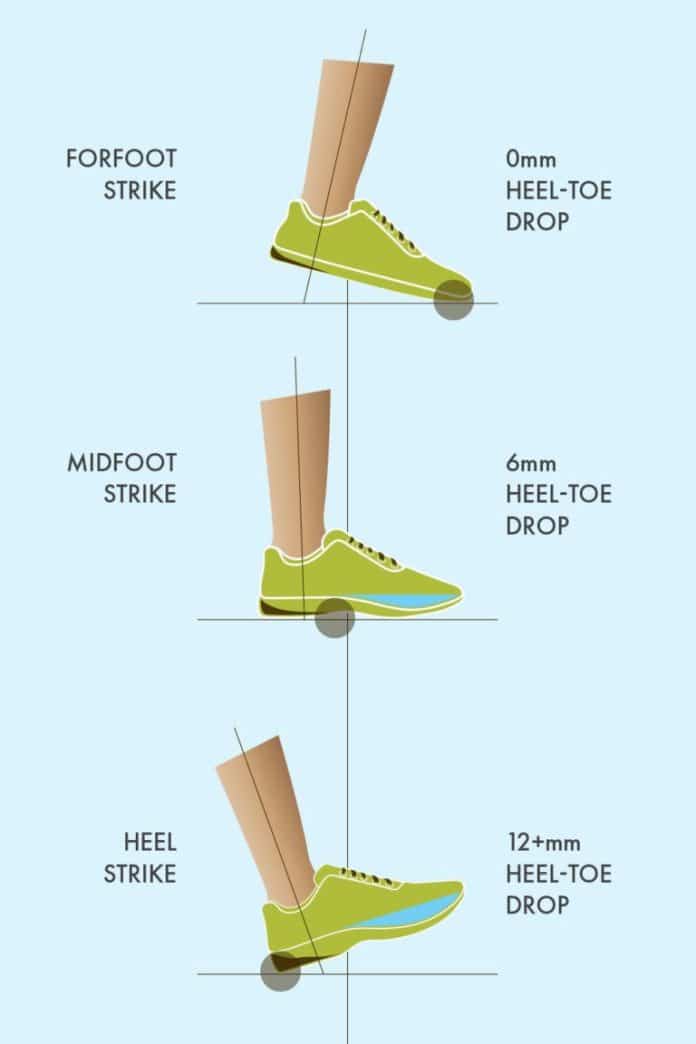In search of the perfect running shoe? One crucial factor to consider is the heel-to-toe drop.
This measurement refers to the difference in height between the shoe’s heel and its toe. But what exactly is the ideal heel-to-toe drop for a running shoe?
With various opinions and theories circulating, it’s time to uncover the truth about this crucial element in finding the perfect pair of kicks for your runs.
Factors to Consider
Running Style
When choosing the right running shoe, your running style is a crucial factor to consider. Are you a heel striker, landing with your heel first? Or perhaps you’re a midfoot or forefoot striker, landing with the middle or front of your foot? Understanding your running style will help determine the cushioning and support you need in a shoe.
Foot Type
Another essential factor to consider is your foot type. Are you someone with a high, low, or neutral arch? The arch of your foot affects how your foot absorbs shock and distributes pressure. Finding a running shoe that provides the proper stability and support to accommodate your foot’s natural structure is essential.
Terrain
The type of terrain you usually run on should also be considered when selecting a running shoe.
If you primarily run on trails or uneven surfaces, you may need a shoe with added traction and stability. On the other hand, if you often run on pavement or a track, a shoe with more cushioning and flexibility might be a better fit.
Injury History
Your injury history is crucial in finding the ideal heel-to-toe drop for your running shoe.
Suppose you have a history of specific injuries, such as shin splints or plantar fasciitis. In that case, choosing a shoe that can help alleviate the stress on affected areas and provide the necessary support to prevent further injuries is essential.
Understanding Heel-to-Toe Drop
Definition
Heel-to-toe drop refers to the difference in height between the heel and the forefoot of a shoe. It is usually measured in millimeters and determines the slope or angle of the shoe.
A high heel-to-toe drop means the heel is significantly higher than the forefoot, creating a steeper slope, while a low heel-to-toe drop means the heel and forefoot are closer in height, resulting in a flatter slope.
Importance
The heel-to-toe drop of a running shoe affects how your foot strikes the ground and the subsequent motion of your lower body.
It plays a significant role in your overall running mechanics, the distribution of impact forces, and your running efficiency. It is essential to understand the impact of the heel-to-toe drop on your running style and choose a shoe that complements your natural foot movement.
Heel-to-Toe Drop and Running Mechanics
Impact Forces
The heel-to-toe drop of a running shoe influences the amount of impact forces your body experiences with each step. A higher drop tends to encourage a heel-striking running form, where the initial contact is made with the heel.
This can increase impact forces and lead to overuse injuries such as shin splints or knee pain. Conversely, a lower drop promotes a more natural midfoot or forefoot striking pattern, which may help distribute impact forces evenly throughout the foot and lower leg.
Running Efficiency
The heel-to-toe drop also affects your running efficiency. With a higher drop, the slope of the shoe promotes a rolling motion from the heel to the forefoot, potentially helping with forward propulsion.
However, a lower drop can be more efficient for runners with a midfoot or forefoot striking style as it allows for a more natural and continuous motion throughout the gait cycle.
Different Heel-to-Toe Drops
Zero Drop
Zero drop refers to a running shoe with no height difference between the heel and forefoot, resulting in a flat platform.
This shoe promotes a more natural foot strike and can benefit runners who prefer a midfoot or forefoot landing. It encourages better alignment and engagement of the foot muscles but may require a gradual transition period if you’re used to a higher drop.
Low Drop
A low-drop running shoe typically has a heel-to-toe drop of 4-6mm. It offers a slight incline from the heel to the forefoot, promoting a more natural foot strike while providing cushioning and support.
Low-drop shoes are a popular choice for runners with a midfoot or forefoot strike and those seeking a balance between barefoot-like running and traditional cushioning.
Medium Drop
A medium-drop running shoe usually falls within the 8-10mm range. This heel-to-toe drop is often favored by runners with a neutral foot strike or those transitioning from a higher drop.
It provides moderate cushioning and support while allowing for a relatively natural foot movement. Medium drop shoes suit a wide range of running styles and are a good option for most runners.
High Drop
A high-drop running shoe typically has a heel-to-toe drop of 12mm or more. This type of shoe encourages a heel-striking pattern and is often preferred by runners who require additional cushioning and stability.
High-drop shoes can help reduce the strain on the lower leg and foot by absorbing more impact forces. However, they may not be suitable for everyone, especially those prone to overuse injuries or with a midfoot or forefoot strike.
Choosing the Right Heel-to-Toe Drop
Consider Personal Preference
Choosing the right heel-to-toe drop ultimately comes down to personal preference. Listening to your body and assessing what feels most comfortable during your runs is essential.
If you’ve been running with a specific drop for a long time and haven’t experienced any issues or discomfort, it might be best to stick with what works for you. However, if you’re considering a change, take the time to gradually transition and pay attention to how your body responds.
Consult with a Running Specialist
If you’re unsure about the ideal heel-to-toe drop for your running shoes, it can be helpful to consult with a running specialist or a knowledgeable shoe retailer.
They can perform a gait analysis to assess your running form and recommend the most suitable drop based on your needs and preferences. Additionally, they can guide you towards shoes with the appropriate cushioning and support for your foot type and injury history.
Heel-to-Toe Drop and Injury Risk
Overuse Injuries
The heel-to-toe drop of a running shoe can influence the risk of specific overuse injuries. For example, a higher drop may increase the likelihood of issues such as shin splints or Achilles tendonitis, particularly for runners with a heel-striking pattern.
On the other hand, a lower drop can reduce the strain on the calf muscles and Achilles tendon, lowering the risk of these types of injuries and finding the right balance that suits your running style and minimizes the risk of developing overuse injuries.
Risk Factors
While the heel-to-toe drop can contribute to injury risk, it’s important to remember that it is among many factors. Other factors such as running surface, training volume, footwear quality, and biomechanics also play significant roles.
It’s essential to take a holistic approach to injury prevention and consider all relevant factors rather than solely focusing on the heel-to-toe drop of your running shoe.
Shoe Recommendations by Heel-to-Toe Drop
Stability Shoes
Stability shoes with a higher heel-to-toe drop can be a good option if you have a pronation issue or need additional support. These shoes provide increased arch support and help control excessive inward rolling of the foot (known as overpronation), which can be a possible cause of specific injuries. Stability shoes are typically recommended for runners with flat feet or stability-related injuries.
Neutral Shoes
Neutral shoes with a medium heel-to-toe drop are versatile for many runners. These shoes offer a balanced combination of cushioning and support, accommodating most foot types and running styles. They balance stability and flexibility well, making them a popular choice for both beginners and experienced runners.
Minimalist Shoes
Minimalist shoes, often characterized by a zero or very low drop, cater to runners who prefer a more natural running experience.
These shoes promote a more barefoot-like feel, encouraging the foot’s natural movement and strengthening the foot muscles. However, minimalist shoes require a gradual transition and may not be suitable for runners with certain foot conditions or injury histories.
Transitioning to a Different Heel-to-Toe Drop
Gradual Transition
If you switch to a running shoe with a different heel-to-toe drop, it’s crucial to do so gradually.
Abrupt changes in shoe drop can lead to muscle imbalances, discomfort, and even injury. Start by incorporating the new shoe into a small portion of your runs and gradually increase the time you wear them.
This allows your body to adapt to the new mechanics gradually and reduces the risk of overloading certain muscle groups.
Strengthening Exercises
Transitioning to a different heel-to-toe drop can also be aided by specific strengthening exercises. Strengthening the muscles in your feet, ankles, and lower legs can help improve stability and support.
Exercises such as calf raises, toe curls and ankle rotations can be beneficial in preparing your body for the new demands of a different shoe drop.
Consider working with a physical therapist or a running coach to develop a strengthening program tailored to your needs.
Common Myths about Heel-to-Toe Drop
High Drop Prevents Injuries
Contrary to popular belief, a high heel-to-toe drop does not guarantee injury prevention. While it may provide extra cushioning and stability, it’s essential to consider other factors such as running form, training volume, and individual biomechanics.
Over-reliance on a high-drop shoe may mask underlying issues and prevent the development of proper technique and strength. It’s essential to find the right balance and not solely rely on heel-to-toe drop as a safeguard against injuries.
Zero Drop is Always Better
While zero-drop or minimalist shoes have gained popularity in recent years, they are not a one-size-fits-all solution.
While they may improve foot and lower leg strength for some runners, they may not be suitable for everyone. Some individuals may require additional support or cushioning due to specific foot conditions or injury histories.
Finding a shoe that aligns with your needs and preferences is essential rather than unthinkingly following trends or recommendations.
Conclusion
As you can see, choosing the ideal heel-to-toe drop for your running shoe is not a one-size-fits-all decision. It requires careful consideration of various factors, including your running style, foot type, terrain, and injury history.
While the heel-to-toe drop does impact your running mechanics and injury risk, it should be viewed as part of a holistic approach to finding the right shoe.
Personal preference, consultation with a running specialist, and careful experimentation will help you determine the best heel-to-toe drop to enhance your running experience and reduce the risk of injuries.
So, lace up your shoes, hit the road, and take the first step toward finding your perfect running companion. Happy running!













































